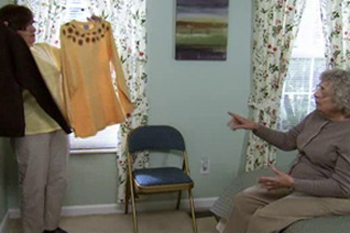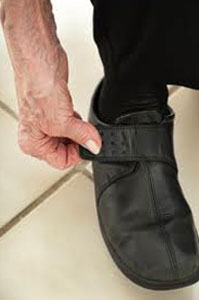What to Do

Let the Person Make Choices
Help the person stay as independent as possible:
- Allow the person to have choices in what to wear.
- Allow the person with dementia to choose from a limited selection of outfits. If the person has a favorite outfit, consider buying several sets of the same clothes.
- Make it simple for the person to choose clothing to wear. Keep closets free of excess and off-season clothing. Arrange clothing in sets that match.
- Let the person dress him or herself as much as possible. Do not pressure or rush the person.
- Do not criticize or correct the person with dementia, even if the clothing is mismatched.

Make the Person Comfortable
- Give the person as much privacy as possible during dressing.
- It is easier to dress in a room that is not too cold and has good lighting.
- Reduce any embarrassment the person might feel by letting him or her know you will leave the room, but stay close by if they need help.
- Compliment the person on the way he or she looks.
Choose Clothes that are Easy to Put On.
- Help the person select clothes that are loose fitting, especially around the waist and hips. A person recovering from surgery for example, will likely want to wear loose fitting casual clothes.
- Choose fabrics that are lightweight and smooth in texture.
- Choose clothing that is easy to put on and remove such as:
- Sweaters that button
- Pants with elastic waists
- Shirts and blouses that button in the front
- Pullover shirts with loose necklines
- Half-ankle socks
- Slip-on shoes or shoes with Velcro® fasteners.
- Try using Velcro® instead of buttons, snaps and zippers which may be difficult for the person to handle or grasp.
- Men can more easily put on boxer shorts that have Y-fronts.
- Have women wear a sports bra or a tank without fasteners.
- If a person cannot get out of bed, have them wear a gown with a back closure.
- A warm, wool cape may be better than a coat as it is easier to put on.
- Remind the person that labels in the garment are the best reminder as to the right and wrong side of the garment.

Follow a Routine
- Encourage the person to dress at the same time each day so he or she knows it is part of a daily routine.
- Arrange clothes in the order that the person typically puts them on.
- Help the person move through each step of dressing. Give the person one item of clothing at a time.
- If the person has a condition affecting their memory or thinking, use short, simple instructions such as “Put on your shirt” rather than “Get dressed”, or “Now put this arm through the sleeve” instead of “Put this blouse on your weak arm”.
Do Not Rush
- Plan dressing so that you and the person have plenty of time.
- Have the person use the bathroom before beginning to dress so that you will not have to stop in the middle of dressing.
Change Clothes Regularly
Not all people want to change their clothes each day. For example, a person with dementia may not want to change clothes before going to bed or not realize their clothing is dirty. A person who is always fatigued will have little energy and may be unwilling to change clothes.
- Provide a clean set of clothes for the person to put on after a shower or bath. Remove the old set of clothes. Then, place clean clothes in the order that they are to be put on. e.g. socks on top followed by underwear etc.
- Make changing clothes a pleasant event, such as getting ready for someone’s visit, putting on something new.
- Check the person’s clothing during the day to make sure it is not soiled.